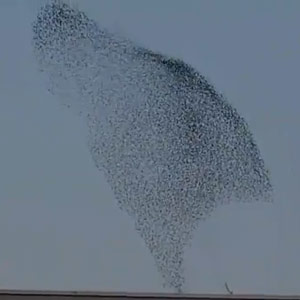Pratique | Débuter
Les vols d’étourneaux fonctionnent comme des systèmes critiques

Vol coordonné d’Étouneaux sansonnets (Sturnus vulgaris) poursuivis par deux faucons.Source : Alexander Smith / Sa chaîne sur Youtube
Introduction
Les grands groupes d’Étourneaux sansonnets (Sturnus vulgaris), qui se forment notamment en hiver près des dortoirs, nous émerveillent : ils volent de façon coordonnée comme s’ils ne formaient qu’un seul être, réagissant tous ensemble de façon quasi-instantanée. Les résultats d’une étude intitulée « Scale-free correlations in starling flocks » menée par des chercheurs italiens ont été publiés en ligne le 14 juin 2010 dans la revue Proceedings of the National Academy of Sciences (PNAS). Ils ont constaté que les interactions comportementales entre individus étaient indépendantes de la taille du vol, suggérant que ces groupes se comportaient comme des systèmes critiques réagissant de façon optimale aux perturbations environnementales.
Abstract
From bird flocks to fish schools, animal groups often seem to react to environmental perturbations as if of one mind.
Most studies in collective animal behavior have aimed to understand how a globally ordered state may emerge from simple behavioral rules. Less effort has been devoted to understanding the origin of collective response, namely the way the group as a whole reacts to its environment. Yet, in the presence of strong predatory pressure on the group, collective response may yield a significant adaptive advantage.
Some Italian researchers suggest that collective response in animal groups may be achieved through scale-free behavioral correlations. By reconstructing the 3D position and velocity of individual birds in large flocks of starlings, they measured to what extent the velocity fluctuations of different birds are correlated to each other. They found that the range of such spatial correlation does not have a constant value, but it scales with the linear size of the flock. This result indicates that behavioral correlations are scale free: The change in the behavioral state of one animal affects and is affected by that of all other animals in the group, no matter how large the group is.
Scale-free correlations provide each animal with an effective perception range much larger than the direct interindividual interaction range, thus enhancing global response to perturbations. These results suggest that flocks behave as critical systems, poised to respond maximally to environmental perturbations.
Poursuivez la lecture de cet article, en vous abonnant dès maintenant !
Découvrez les Archives d’Ornithomedia.com
Pour seulement 10,00 €TTC/an (ou 6,00 € les 6 mois)
Profitez de plusieurs centaines d’articles en accès illimité et sans aucun engagement.
Compléments
Ouvrages recommandés
- Le guide Ornitho de L. Svensson et al
- Cap sur les migrations d’oiseaux de Loyer Bertrand
Sources
- Andrea Cavagnaa, Alessio Cimarelli, Irene Giardina, Giorgio Parisi, Raffaele Santagati, Fabio Stefanini et Massimiliano Viale (2010). Scale-free correlations in starling flocks. PNAS. Date de mise à jour : 14/06. http://www.pnas.org/content/early/2010/06/11/1005766107.abstract
- Damienne Provitolo. Théorie de l’auto-organisation critique. Hypergeo. http://www.hypergeo.eu/spip.php?article426
- Wikipedia (201). Auto-organisation. http://fr.wikipedia.org/wiki/Auto-organisation





Aucun commentaire sur ce sujet
Participer à la discussion !